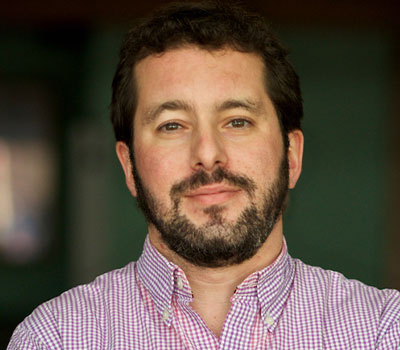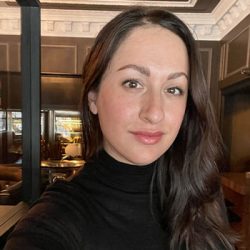Andrew Fortgang opened Le Pigeon in 2006 with chef and partner Gabriel Rucker. They opened Canard in the spring of 2018 and found creative ways to keep the lights on at both over the past two years. That pandemic experience led Fortgang into Flor, a new wine shop he opened with a new partner the day before Thanksgiving, 2021. “It was something I had in mind that, one day, when my knees were too shot from the restaurants…” he says, though he has since found that running a retail store is not that easy. “I’ve learned a thing or two since we opened,” Fortgang says, having sold wine out of his restaurants at retail pricing through the pandemic. “We sometimes had access to more wine than we knew what to do with. So, I started to talk about it with Sergio [Licea, who had been the wine director at *Little Bird Bistro⸶, another sibling restaurant]. Gabriel is also a partner. It began like a boulder rolling down the hill: Let’s do an online thing with curated wine packs and special bottles, we said. Well, if we’re going to do that, let’s have a place in the front that’s comfortable, with a few bottles and other things so people might grab something extra. Then, as we started looking at spaces, we thought, let’s have a regular wine shop. Then, we thought, let’s not make it like a regular shop. Let’s give people the option to have a glass of wine while the browse through. So, it’s a 1,500 square foot shop with tastings.”


You noted on your poll that entrée prices are up, but not wine list prices. Even so, the price of the lowest-priced wine is up.
We had closed in March of 2020 and when Le Pigeon reopened in June or July with four tables, we were just doing tasting menus. (Prior to pandemic, we offered an à la carte menu as well.) We closed again in November, then reopened in May of 2021. Now, we’ve added back tables to the point where we have as many as we will ever have again. We’re sticking to the tasting menu format, but with fewer seats. Our menu price has gone up, in keeping with inflation and costs. The highest-priced wines haven’t changed, but we’re added fewer lowest-priced wines.
The vast majority of our wine sales are part of our wine pairings. In terms of bottle sales, very few people who order bottles of wine order the lower end. People going with bottles are ordering mid-tier or higher-end wines.
Because so much what we are doing is tastings, we’re picking our by-the-glass wines almost purely for what’s on the menu. I had maintained two or three pretty inexpensive glass pours, but we don’t feel the need to have a $10 or $12 glass. Our cheapest glass pour has creeped up by a buck or two.
Last year, you listed the Nicolas Chemarin Beaujolais Le Rocher for $60 as your top-selling wine. The year before that, you listed Pierre Sèches St-Joseph for $65 as you biggest new success. This year, the top two wines are DRC Richebourg at $3,800 and Jacques-Frédéric Mugnier Musigny at $2,600. Are you sourcing those wines from auction and is that a new program for you? What’s driving the interest in purchasing such expensive wines?
That wasn’t by bottle volume, those were the top two wines by dollar volume. If I would have done it by bottle volume, it would have been a long list of things that were four of this and five of that. For 2021, May through December, it was a seven-month period of tasting-menu only; nothing by the bottle sold more than four or five.
Those Burgundies were just fairly recent releases, bought through distribution.
When I did the poll this year, for wines sold by the bottle, those were the top two. Those wines, in any given year, you put them on the list and one day, someone walks in and grabs them. Six or seven months go by, and it happens again.
Who buys the Moselle Pinot Noir, and how does it relate to the Willamette Pinot Noirs you list?
That was one we were pairing with a dish, and it was on the by-the-glass menu. Every server working loved it. And it’s pinot noir. When people ordered a glass of the pinot, because of the profile and the price point, when guests said, “We’re looking for a bottle of wine for our meal,” our staff would gravitate toward that. Our team gets excited about new things. If you are a server working in Portland, you are probably going to be more excited about this delicious pinot from a place you’re not familiar with [than a wine from Oregon].
How has the pandemic changed your role at the restaurant, and how might that impact your approach to your job when the restaurant reopens for indoor dining?
I joke that I used up all my angst, I don’t have that emotion any more, I have stress, I have worry, but I don’t have that stomach-turning angst, I used it all up. I come at it not just as a wine buyer but as a small business owner feeling the weight of people’s livelihoods relying on you.
At the end of 2019, we closed one restaurant. 2020 was supposed to be the year of coasting; that didn’t happen. I told myself during the pandemic that I wasn’t going to make my life more complicated, then I went and opened a wine shop.
I’m working on accepting what I can and can’t do in a day, and relying on my peers and coworkers more. And knowing when it’s time to go home.
Joshua Greene is the editor and publisher of Wine & Spirits magazine.
This is a W&S web exclusive. Get access to all of our feature stories by signing up today.




















